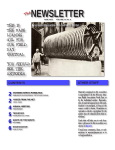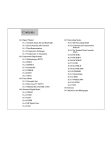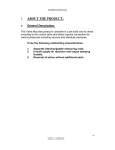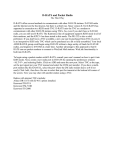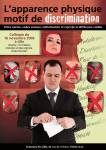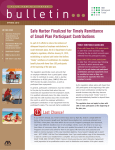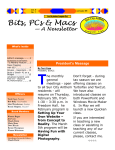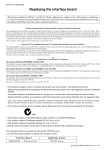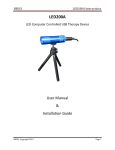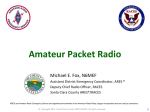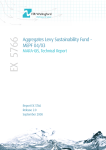Download april - mara north east
Transcript
The NEWSLETTER APRIL 2015 VOLUME 15, No. 4 Mercury Amateur Radio Association - MARA North America - North East The month of April is typically rainy, so make sure you keep your radios dry! CONTENTS 2 4 5 FEATURE ARTICLE • WINLINK 2000 - BOB, N3TS GRANDMA MARA’S RAMBLINGS • RAMBLINGS OF AN OLDER PERSON - THIS AND THAT TECH and other STUFF • STRAIGHT KEY ADJUSTMENT • A LINK TO THE FAMOUS 1937 VERTICAL ANTENNA REPORT • SLEEPING USB PORTS • APRIL FOOL’S GAG 6 7 7 FIELD DAY DATES • JUNE 2015 - 27th AND 28th QUOTE OF THE MONTH • RONALD REAGAN DI-DA-DI-DA-DIT • IT’S TAX TIME AGAIN - OH JOY, OH DELIGHT! OTHER STUFF Material contained in this newsletter is copyrighted © by the Mercury Amateur Radio Association North East, or by the individual author where so noted. Reproduction of material appearing in this publication is encouraged, as long as the source credit is shown. Permission to reproduce articles copyrighted by the author must be obtained from that individual. Links that will take you to web locations referenced in this newsletter are shown in BOLD blue text. E-mail your comments, ideas, or submissions to [email protected] or to ve1vq@ eastlink.ca Past issues of The NEWSLETTER may be viewed at http://ne.mara.net/newsletters.htm FEATURE ARTICLE BOB - N3TS Enhanced Digital Messaging – WinLink 2000 I n a disaster, just when needed most, we frequently learn the Internet is down or disrupted in the impacted area/areas. Along with the collapse of the Internet, we frequently experience the widespread slow-down, if not total loss of the use of our land-lines, as well as our cell phone operation. Where then can we turn for the type of communication to which we have become so accustomed? You guessed it, high frequency (HF) Amateur Radio stations survive when the much needed national MARA NORTHEAST NEWSLETTER infrastructure does not. HF radio provides excellent point-to-point or medium/long-haul circuits. History has already proven that HF is excellent for high-priority, low volume message traffic. In an emergency, the term low volume becomes a relative term. To achieve the known advantages of HF radio communications, experienced Amateur Radio operators are necessary. E-mail, using the primary infrastructure mentioned above, is the standard method for fast written communications today. It is used by extensively by individuals, government agencies, and other organizations. When the internet goes down, normal e-mail no longer flows and “normal” operations come to a halt without emergency communications. The subject of this article is HF emergency communications, but that is provided best by skilled Amateur Radio operators who have trained and have existing plans in place to act. I don’t know where the next emergency will require Amateur Radio communications support (see https:// www.youtube.com/ watch?v=F6PCL697bJQ) , but I do know that many of the users will, during an emergency, still want to send and receive e-mail. We know the issue, so let’s talk about an available solution. What we will discuss here can also be used in VHF/UHF communications, but that is another article. With HF we can keep agencies and organizations connected for today’s complex messages without a standard Internet connection. We can do this by learning to use WinLink 2000. We must THE APRIL 2015 EDITION - - PAGE 2 make emergency communications as easy and transparent as possible for those who most need it. The WinLink 2000 system allows HF Amateur Radio operators to “send and receive” e-mail with those still able to operate the standard e-mail system. The WinLink 2000 system will also “hold and forward” e-mail from the standard e-mail users for the HF Amateur Radio operators. The e-mail will be delivered when the HF operator re-enters the WinLink 2000 system. WinLink 2000 also provides point-to-point capability for HF operators to send and receive e-mail. See https:// www.youtube.com/ watch?v=wCCTLd5APdk Once you send an e-mail through the WinLink 2000 system you receive a system e-mail address that is retained by the system for 400 days. Each time you send an e-mail the 400 day clock is restarted. For example MARA NORTHEAST NEWSLETTER my WinLink 2000 e-mail address is [email protected]. Our collective WinLink addresses will be good to know should we need to contact each other during an emergency. RMS Express (FREE) a software suite for Windows (http://www.arrl. org/news/rms-express-with-winmornow-available-forwinlink-2000) is the preferred WinLink 2000 radio e-mail client. The RMS Express user manual is found at http:// softwaretopic. informer.com/ rms-express-usermanual/. WinLink 2000 is in active development by the WinLink Development Team and is well-supported. WINMOR is the HF digital protocol designed for use with the WinLink 2000 network. WINMOR provides an alternative to external PACTOR hardware. RMS Express software with the WINMOR protocol requires no special hardware (as required for PACTOR) beyond the ability to run digital communications. Here is a look at RMS Express screens used to send and receive HF e-mail. Also see a sample transmission THE APRIL 2015 EDITION - - PAGE 3 tions contain multiple stations. There are approximately 9,500 radio users and approximately 98,000 Internet e-mail recipients. Monthly traffic averages over 150,000 messages or 280,000 minutes. My message is, if you as an Amateur Radio operator don’t already use the WinLink 2000 system, then please See HMS Bounty’s Captain Sends Winlink Message -- Saves 14 Crew at http://www.winlink.org/content/hms_bountys_captain_sends_winlink_message_saves_14_crew The new WINMOR component of RMS EXPRESS allows users to access the WinLink 2000 network on HF with virtually no external hardware - just a transceiver and a sound card-equipped computer. at https://www.youtube.com/watch?v=lxLPWcos7gA. Just remember to keep the transmit power low because of the heavy duty cycle. WinLink 2000 provides a dependable Amateur radio e-mail messaging network. The last figures I saw on this system show that it has been supporting emergency communications with a 99% availability for several years. There are over 50 Amateur Radio emergency communication locations with 25 in the USA. Many loca- MARA NORTHEAST NEWSLETTER learn. It is the fastest, most dependable, transparent back-up e-mail system that bridges any distance. It can automatically switch from normal “wired” Internet connections to a radio connection via VHF for short haul or HF for world-wide communications. Waiting until the emergency is underway will be too late to learn how to operate the system. So why not learn how to use WinLink 2000 ASAP? Grandma Mara’s RAMBLINGS A s much as I hate to think about it, several months have passed since my bunion surgery and I’m pretty well recovered. That part’s good. The part I don’t like is that I’ll be checking into the OR again for the other foot, later this summer. A tentative date is the end of August, but that will be firmed up in the next month or so. Funny how you don’t think about it for the first one, That’s, I guess, because you really don’t know what to expect. Having experienced it first hand (or foot) I’m sure thinking about it for the second and really dreading it. Walter says it will be “a walk in the park”! He also says this is the last I can talk about it! Darn, I guess I’ll have to go back to radio things. THE APRIL 2015 EDITION - - PAGE 4 Just a few more months to Field Day, and Walter has been using his free time to prepare. Not just the new vertical he’s been working on but also some other ideas he and the ham friends he talks with Just a few more months on-line have been to Field Day, and Walter discussing. The folks at the re- has been using his free tirement home have time to prepare. been working on their “communications room”. From what was a sort of junk storage room of a decent size, they have created a really nice area for their club. Radio has kind of caught on there. Looks like we will be holding another course come September or October. Several of the staff “graduated” in the one held over this past fall and early winter, including the home’s lady administrator, having seen the change to those residents who have gotten their licenses. Keeps up, they’ll make it a prerequisite to move in there - hi! It seems so strange to think of “our little Wendy”, who persuaded her mother to bring her over to meet me just a few years ago, now having a boy friend. All the studying they did together paid off, with him getting his General ticket. She says he did so well, she tried to get him to go for his Extra, but seems that he felt he needed more time to study and prepare. Wendy thinks he might just want to spend more time with her. Seeing the two of them together, I think she is correct. And I don’t think she minds in the least. A OT ND HE R TECH E by VE1VQ STUFF very once in a while, you have to re-think how you are doing things - things you may have been doing a certain way for a long time. Recently, that re-think was about my NYE VIKING 310 straight key. I had removed it from the desk along side my transceiver and was using it on the bench to key the Twin-T audio oscillator circuit shown in last month’s column. My excuse for all of the mis-sent characters was that the placement of the key (balanced on top of the power supply) was wrong. A second excuse was that I had no desk top to rest my arm, so instead it was hanging in the air, a position I was not used to. Placing it back in it’s normal operating position did improve my sending but the whole thing made me stop MARA NORTHEAST NEWSLETTER and think for a few seconds. Perhaps, some adjustment might make things even better. The first thing to do is to loosen the locknuts on the The E.F. Johnson Speed-X is an example of a typical straight CW key space adjusting screw (1), the spring tension screw (2), and the trunnion screws (3). Next loosen the trunnion screws themselves. Not so much that the lever falls out but enough to allow some side movement. Loosen the Before we go any further, a word about cleaning key contacts. On keys of any quality, these are usually silver or gold alloy, or silver or gold plating. Do not (as in NEVER) use any kind of file or sand paper, no matter how fine, to clean them. I’ve seen some mention of the use a dollar bill, but I prefer to use a piece of plain brown paper bag. Lightly moisten the paper with rubbing alcohol or contact cleaner. Place the paper between the key contacts, and while holding the lever down with a finger’s very light pressure, pull the paper through. Repeat several times, more if the paper comes out with a dirty streak. space adjusting screw to about an 1/8-inch gap. Loosen the spring tension screw to the point where it just barely lifts the key lever to the top (un-keyed or open) position. Now, adjust the trunnion screws to center the key contacts in line with each other. Tighten the two screws only enough to just barely remove any side play in the lever. Do not overtighten. You want to introduce as little drag as possible. There are two schools of thought about lubrication on the ends of the trunnion screws. One says you should lightly lube, and by lightly I mean a tiny drop of a good quality light machine oil on the pointy end of a straight pin or needle. The other says you shouldn’t use any lubrication as that just attracts dust which will cause future problems. I personally tend towards the no-oil side of the argument. Once you have the trunnion screws adjusted the way you want, tighten the locknuts finger tight. Depending THE APRIL 2015 EDITION - - PAGE 5 on your finger tightening ability, you may want to use a pair of small pliers to tighten them a smidgen more. If you use a tool, make sure you pad the jaws with several layers of cloth to avoid marring the surface of the nuts. A smidgen more means just that. Not a full turn, or a half, or even a quarter. It means just a couple of degrees tighter, hardly enough to see them turn! Tightening the locknuts may cause the trunnion screws to further tighten. You may have to loosen these screws a tiny bit more than your initial best setting, and let the locknuts place them in the optimal position. Next, adjust the Contact Space Adjusting screw to your preferred contact gap. If you don’t Don’t be afraid to re-try have a lot of experithese settings every now ence with hand sent and then, especially as code, set them to about a 1/16-inch you are in the early stagto start. As you gain es of using code on the more experience, you may want to set air. the gap to less (or more) depending on your preference. Now, set the Spring Tension screw to provide the desired and comfortable lever tension. Lighter is better than cranked up harder, but again, that is very much a personal preference. You may find that adjusting screws 1 and 2 interact with each other as far as your perception of the best feel. Play around with them until you reach a point comfortable for you. Tighten the locknuts to keep the adjustments from changing. Don’t be afraid to re-try these settings every now and then, especially as you are in the early stages of using code on the air. Your personal preferences will change as your experience and sending speed increase. In my case, getting on the air using CW and getting some practice would be the best thing I could do! had gone “to sleep”. The cure for this, in my case running Windows 7, is as follows: THE FAMOUS 1937 VERTICAL ANTENNA REPORT ARRL FIELD DAY Many of you, I’m sure, have heard about the famous and oft quoted report produced by Brown, Lewis, and Epstein of RCA in 1937, regarding vertical antennas. Specifically, vertical antennas for AM band broadcast stations. If you want to read it and see for yourself what it really says, check it out at http://www.docdroid.net/ suzs/ground-systems-as-a-factor-in-antenna-efficiency. pdf.html 1. Right click on empty spot on main screen/desktop. 2. Left click on Personalize 3. Left click on Screen Saver 4. Under Power Management click on Change power settings. 5. Under Select a power plan, click Change plan settings on which ever one you have already selected. 6. For Put the computer to sleep, select Never. Since I was doing this on a laptop, I left the On battery setting at 15 minutes and set the Plugged in setting to Never. If you are running Windows 7 (and possibly other versions of Windows) and have a similar problem, try this and see if it works for you. This might keep your USB ports alive and awake. THE REQUISITE APRIL FOOL’S GAG This is the April issue of the Newsletter, and most publications of a monthly nature sneak some type of joke in somewhere. So, here it is! Everything else in these pages is April Fool’s free. Guaranteed! The sign shown on the right advertises an evening of Bingo at the Ag Society building. The special feature of the evening is Ham Bingo. Obviously, a Ham will be the special prize. You get to take home your very own Ham. What is not clear is whether the Ham comes with his or her station equipment, or if the winner has to provide it. Field Day is always the fourth full weekend of June, beginning at 1800 UTC Saturday and running through 2059 UTC Sunday. Field Day 2015 is June 27-28. SLEEPING USB PORTS No local club to join up with, or they are way too serious and you just want to operate for the fun of it? I’ve occasionally had a problem with my SignaLink USB failing to work after being on receive and left to its own devices for a while. I found that the laptop’s USB port Well then, set up by yourself, or find someone of like mind to operate with you! MARA NORTHEAST NEWSLETTER THE APRIL 2015 EDITION - - PAGE 6 QUOTE OF THE MONTH “The government’s view of the economy could be summed up in a few short phrases: If it moves, tax it. If it keeps moving, regulate it. And if it stops moving, subsidize it.” I Ronald Reagan DI-DAH-DI-DAH D I T t’s that time of the year again, the time of the annual mad scramble to try to find the receipts and other necessary paperwork in order to try to fend off the tax person. Is it just me or do the taxes seem to be more and more each year, and not just because I might be bringing more home? I know it’s our patriotic and civic duty to pay taxes, and I know it’s all put to a good cause, as decided by our politicians and government bureaucrats. Still, I could buy a nice tower and multi-band beam, and a new top of the line rig for the shack. That seems like a good cause to my way of thinking! But then, you hear of things like the one in 2007, “where the National Science Foundation committed more than $500,000 to study the mobility of shrimp by conducting experiments that involved placing the crustaceans on treadmills”. Or the news that “some members of Congress are trying to restore billions in funding for a new factory at the Los Alamos National Laboratory to make plutonium cores for nuclear bombs that the military doesn’t need. Meanwhile, President Obama is plowing ahead with plans to make plutonium fuel rods for power reactors that no power company wants to buy. Together, construction costs for these two radioactive white elephants add up to over $10 billion, and rising.” Lest you think our Canadian government up here is any better, “the Auditor General was unable to account for $3.1 billion of the $12.9 billion designated to the Public Security and Anti-Terrorism Initiative.” Or where the government “assured Canadians that it would cost but $9 billion to purchase the new ‘stealth’ MARA NORTHEAST NEWSLETTER fighters and replace our aging fleet of CF-18’s. After ignoring repeated demands for supporting documentation for this claim by the Parliamentary Budget Officer it was eventually revealed that the acquisition and maintenance costs of the proposed F-35 purchase would reach a staggering $45 billion over the lifetime of the fighter – a full five times more than the Conservatives claimed. Add to this the F-35 prototypes’ ongoing engine problems, its inability to operate in cold temperatures (ie: the Arctic) and [the] inability to fly at night.” The Canadian Auditor General has the responsibility of “auditing” the government departments. In the annual report to Parliament and the Canadian people the AG pulls no punches in detailing mismanagement of taxpayers’ dollars. Makes the government of the day squirm, always promising to immediately address and rectify all of the damaging findings. The opposition parties, of course, love the report! And our governments still want us to have the faith that they are spending our tax dollars wisely. I’ll tell you, it gets harder and harder to see my taxes used in this “responsible” manner. If they let us use some of that money we pay them in taxes to use for the purchase of ham gear, just think how much better off the economy would be! Just think how much better our stations would be! Perhaps we should start a grass-roots movement to have our governments allow a one-hundred per cent deduction for ham gear purchased. Maybe even twohundred per cent. I’d vote for that! Until next month, VE1VQ Remember - we’re always looking for Articles for the Newsletter. THE APRIL 2015 EDITION - - PAGE 7







